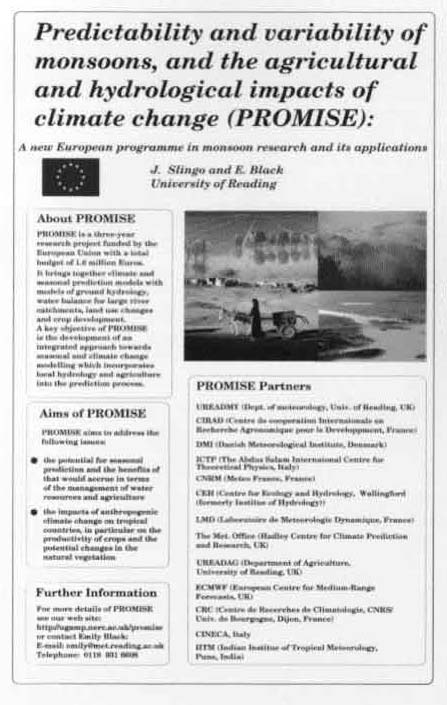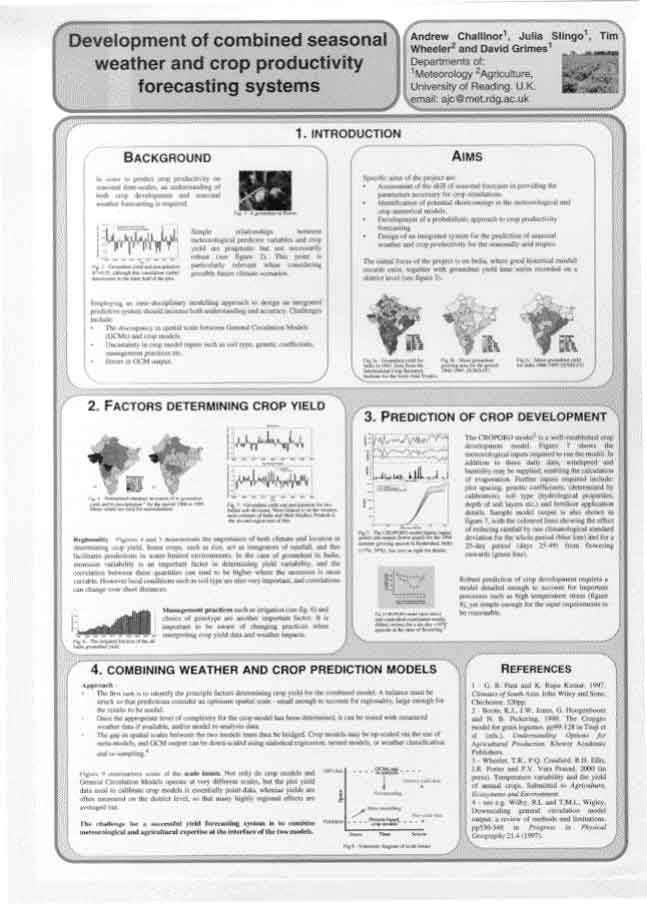 |
|||||||||||
|
September 19th-21st, 2000 Papers Indian Ocean SST variability and its effect on tropical East African rainfall over the last 128 years E. Black, J. Slingo (Presentation) Development of combined seasonal weather and crop productivity forecasting systems. Andrew Challinor, David Grimes, Julia Slingo, Chris Thorncroft, Peter Craufurd, Tim Wheeler (Poster) Predictability and variability of monsoons, and the agricultural and hydrological impacts of climate change (PROMISE): A new European programme in monsoon research and its applications J. Slingo and E. Black (Poster) Abstracts Indian Ocean SST variability and its effect on tropical East African rainfall over the last 128 years E. Black, J. Slingo CGAM, University of Reading In 1997-98, the sea surface temperature of the Indian Ocean was unusually high off the African coast and low near Sumatra, creating an SST anomaly dipole. This resulted in reversal of the normal climatological gradient in Indian Ocean SST - with the SST between October 1997 and June 1998 increasing from east to west rather than from west to east. We present an analysis of 128 years of SST data which puts the 1997-98 event in the context of long-term variability in Indian Ocean SST. Our study reveals several previous incidences of similar SST anomaly dipoles which are used to derive a composite anomaly pattern. It has been proposed that the SST anomaly dipole affects the climate of the surrounding continents. As an example, its association with rainfall anomalies in tropical East Africa is investigated using collations of SST and precipitation data. It is shown that the development of an SST dipole often co-incides with high East African rainfall. For example a dipole developed in 1961 - the same year as devastating floods in Kenya. Thus, improved understanding of the dipole mode in the Indian Ocean may lead to greater predictability of tropical East African rainfall. Back to top
Development of combined seasonal weather and crop productivity forecasting systems. Andrew Challinor, David Grimes, Julia Slingo, Chris Thorncroft (1) Peter Craufurd, Tim Wheeler (2) (1) Dept of Meteorology, University of Reading (2) Dept of Agriculture, University of Reading Food production in seasonally arid areas is inherently risky, and productivity shows variability on a number of time-scales. An analysis of the variability of Groundnut yield and precipitation in India is presented, and some conclusions are drawn regarding research topics which need to be investigated as part of a planned combined seasonal weather and crop productivity forecasting system. One such topic is robust prediction of crop development. This implies both the complexity necessary to model effects such as high temperature stresses and the simplicity necessary for the model to be valid over large regions and over many genotypes and/or crops. Appropriate methods will need to be determined for combining crop models with NWP models. Particular attention should be given to the issue of matching the spatial and temporal scales on which the two models operate. On the seasonal time-scale there is a need to combine the largely functional models of crop adaptation and yield responses to drought and heat stress, to the probabilistic models used in seasonal forecasting. Back to top
Predictability and variability of monsoons, and the agricultural and hydrological impacts of climate change (PROMISE): A new European programme in monsoon research and its applications J. Slingo (1) and E. Black (1) (1) Centre for Global Atmospheric Modelling, Department of Meteorology, University of Reading PROMISE is a new 3-year European programme funded by the European Union which supports 12 research groups working on climate and seasonal prediction, crop modelling and land hydrology. PROMISE is an interdisciplinary project which will develop further the atmospheric science base in seasonal and climate change prediction for monsoon-affected countries, and will consolidate the links between atmospheric science and the impacts communities related to hydrology and agriculture. A particular aim of PROMISE is to develop an integrated approach towards seasonal and climate change prediction in which the impacts on local hydrology and agriculture are part of the prediction process. PROMISE aims to address two key issues for monsoon-affected countries, whose seasonally arid climates mean that they are highly vulnerable to changes in the seasonal behaviour of the monsoon. These key issues are: (i) the potential for seasonal prediction and the benefits that would accrue in terms of the management of water resources and agriculture, and (ii) the impacts of anthropogenic climate change on these semi-arid regions, in particular on the availability of water resources for human use, and on the productivity of crops and the potential changes in the natural vegetation. Of particular relevance to agriculture and hydrology will be the change in the incidence of extreme events on interannual (flood vs. drought) and subseasonal (wet vs. dry spells)timescales Back to top Posters To see a larger version, click on the image below: |

